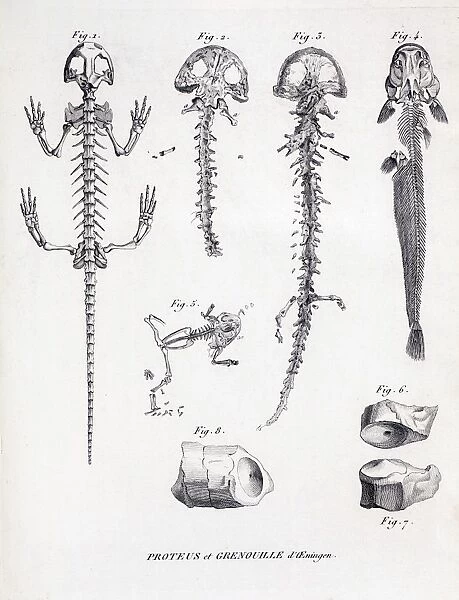Photo Mug : 1812 Cuvier on Scheuchzers flood victim
![]()

Home Decor from Science Photo Library
1812 Cuvier on Scheuchzers flood victim
Illustration in Vol. 4 of Cuviers " Ossamens Fossiles" 1812. In 1726 Scheuchzer illustrated Homo Diluvii testis as a fossil human victim of the flood. In 1811 Baron Cuvier, who famously said " there are no human fossils", took a look at the specimen. His work revealed more of the limbs and many obviously non-human features. He identified it correctly as a giant Salamander close to proteus. There are many accounts of this incident but few note that Cuvier cites two different specimens (here Fig 2 is Scheuchzer s, but Fig 3 is different and more complete specimen of Dr. Amman of Zurich). The current genus name Andrias was coined in 1837. Hence the current scientific name Andrias (image of man) scheuchzeri. There is a living member of the genus A. davidianus, the Japanese giant salamander. Cuvier also showed Scheuchzers illustrated human vertebrae" (Fig. 6&7) belong to a fossil crocodile
Science Photo Library features Science and Medical images including photos and illustrations
Media ID 6317395
© PAUL D STEWART/SCIENCE PHOTO LIBRARY
Bible Black And White Creationism Creationist Cuvier Flood Human Fossil Paleontologist Physica Sacra Giant Salamander Mono Chrome Palaeontology Scheuchzer The Flood
Large Photo Mug (15 oz)
Bring your historical moments to life with our Media Storehouse Photo Mugs. Featuring the captivating illustration "1812 Cuvier on Scheuchzer's flood victim" by Paul D. Stewart from Science Photo Library, these mugs showcase the intriguing image from Volume 4 of Cuvier's "Ossamens Fossiles" (1812). This illustration, which depicts Georges-Louis Leclerc, Comte de Buffon, examining the famed fossil "Homo Diluvii testis," or "The Man of the Flood," discovered by Johann Jakob Scheuchzer in 1726, adds an intellectual and thought-provoking touch to your daily routine. Each mug holds your favorite beverage and is designed to showcase the image in vibrant detail, making it a unique and fascinating addition to your collection. Embrace the power of history with every sip from our Media Storehouse Photo Mugs.
Elevate your coffee or tea experience with our premium white ceramic mug. Its wide, comfortable handle makes drinking easy, and you can rely on it to be both microwave and dishwasher safe. Sold in single units, preview may show both sides of the same mug so you can see how the picture wraps around.
Elevate your coffee or tea experience with our premium white ceramic mug. Its wide, comfortable handle makes drinking easy, and you can rely on it to be both microwave and dishwasher safe. Sold in single units, preview may show both sides of the same mug so you can see how the picture wraps around.
These are individually made so all sizes are approximate
EDITORS COMMENTS
This print showcases an illustration from Volume 4 of Cuvier's "Ossamens Fossiles" published in 1812. The image depicts a significant moment in the history of paleontology, specifically related to the controversial topic of human fossils and their connection to biblical events. In 1726, Scheuchzer presented his famous illustration titled "Homo Diluvii testis" depicting a fossilized human victim of the flood described in the Bible. However, renowned Baron Cuvier, who famously declared that there were no human fossils, examined this specimen in 1811 with intriguing results. Cuvier's meticulous work revealed additional limbs and distinct non-human characteristics. He correctly identified it as a giant Salamander closely resembling proteus rather than a human being. It is worth noting that Cuvier cited two different specimens: Fig 2 representing Scheuchzer's work and Fig 3 displaying Dr. Amman's more complete specimen from Zurich. The scientific name Andrias scheuchzeri was coined for this ancient creature in 1837 due to its resemblance to humans (Andrias meaning "image of man"). Interestingly, there exists a living member of this genus called A. davidianus – the Japanese giant salamander. Furthermore, Cuvier also debunked another misidentification by demonstrating that Scheuchzer's illustrated human vertebrae actually belonged to a fossil crocodile rather than Homo Diluvii testis. This thought-provoking image sheds light on the intersection between science and religious beliefs while highlighting important advancements made by paleontologists like Baron Cuvier during their quest for knowledge about our planet's prehistoric past.
MADE IN THE USA
Safe Shipping with 30 Day Money Back Guarantee
FREE PERSONALISATION*
We are proud to offer a range of customisation features including Personalised Captions, Color Filters and Picture Zoom Tools
SECURE PAYMENTS
We happily accept a wide range of payment options so you can pay for the things you need in the way that is most convenient for you
* Options may vary by product and licensing agreement. Zoomed Pictures can be adjusted in the Cart.


